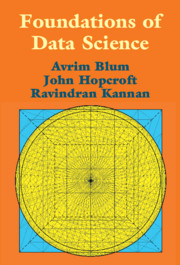Refine listing
Actions for selected content:
9096 results in Communications, Signal Processing and Information Theory
Index
-
- Book:
- The Probability Companion for Engineering and Computer Science
- Published online:
- 03 January 2020
- Print publication:
- 23 January 2020, pp 454-458
-
- Chapter
- Export citation
Frontmatter
-
- Book:
- The Probability Companion for Engineering and Computer Science
- Published online:
- 03 January 2020
- Print publication:
- 23 January 2020, pp i-iv
-
- Chapter
- Export citation

Foundations of Data Science
-
- Published online:
- 17 January 2020
- Print publication:
- 23 January 2020
Index
-
- Book:
- Advanced Digital Signal Processing of Seismic Data
- Published online:
- 24 December 2019
- Print publication:
- 16 January 2020, pp 323-326
-
- Chapter
- Export citation
6 - Fundamentals of Digital Optimal Filtering
- from Part III - Statistical Digital Signal Processing for Seismic Data
-
- Book:
- Advanced Digital Signal Processing of Seismic Data
- Published online:
- 24 December 2019
- Print publication:
- 16 January 2020, pp 273-284
-
- Chapter
- Export citation
1 - Introduction
- from Part I - Seismic Theory Background
-
- Book:
- Advanced Digital Signal Processing of Seismic Data
- Published online:
- 24 December 2019
- Print publication:
- 16 January 2020, pp 3-41
-
- Chapter
- Export citation
7 - Seismic Deconvolution
- from Part III - Statistical Digital Signal Processing for Seismic Data
-
- Book:
- Advanced Digital Signal Processing of Seismic Data
- Published online:
- 24 December 2019
- Print publication:
- 16 January 2020, pp 285-297
-
- Chapter
- Export citation
4 - Sampling Theorem for Seismic Data
- from Part II - Deterministic Digital Signal Processing for Seismic Data
-
- Book:
- Advanced Digital Signal Processing of Seismic Data
- Published online:
- 24 December 2019
- Print publication:
- 16 January 2020, pp 193-220
-
- Chapter
- Export citation
Part III - Statistical Digital Signal Processing for Seismic Data
-
- Book:
- Advanced Digital Signal Processing of Seismic Data
- Published online:
- 24 December 2019
- Print publication:
- 16 January 2020, pp 271-272
-
- Chapter
- Export citation
Frontmatter
-
- Book:
- Advanced Digital Signal Processing of Seismic Data
- Published online:
- 24 December 2019
- Print publication:
- 16 January 2020, pp i-iv
-
- Chapter
- Export citation
Contents
-
- Book:
- Advanced Digital Signal Processing of Seismic Data
- Published online:
- 24 December 2019
- Print publication:
- 16 January 2020, pp vii-x
-
- Chapter
- Export citation
References
-
- Book:
- Advanced Digital Signal Processing of Seismic Data
- Published online:
- 24 December 2019
- Print publication:
- 16 January 2020, pp 313-322
-
- Chapter
- Export citation
Preface
-
- Book:
- Advanced Digital Signal Processing of Seismic Data
- Published online:
- 24 December 2019
- Print publication:
- 16 January 2020, pp xi-xiv
-
- Chapter
- Export citation
Part II - Deterministic Digital Signal Processing for Seismic Data
-
- Book:
- Advanced Digital Signal Processing of Seismic Data
- Published online:
- 24 December 2019
- Print publication:
- 16 January 2020, pp 115-116
-
- Chapter
- Export citation
Dedication
-
- Book:
- Advanced Digital Signal Processing of Seismic Data
- Published online:
- 24 December 2019
- Print publication:
- 16 January 2020, pp v-vi
-
- Chapter
- Export citation
5 - Seismic Applications of Digital Filtering Theory
- from Part II - Deterministic Digital Signal Processing for Seismic Data
-
- Book:
- Advanced Digital Signal Processing of Seismic Data
- Published online:
- 24 December 2019
- Print publication:
- 16 January 2020, pp 221-270
-
- Chapter
- Export citation
8 - Seismic Wavelet Processing
- from Part III - Statistical Digital Signal Processing for Seismic Data
-
- Book:
- Advanced Digital Signal Processing of Seismic Data
- Published online:
- 24 December 2019
- Print publication:
- 16 January 2020, pp 298-312
-
- Chapter
- Export citation
2 - Seismic Theory and Reflection Surveying: A Necessary Background
- from Part I - Seismic Theory Background
-
- Book:
- Advanced Digital Signal Processing of Seismic Data
- Published online:
- 24 December 2019
- Print publication:
- 16 January 2020, pp 42-114
-
- Chapter
- Export citation
Part I - Seismic Theory Background
-
- Book:
- Advanced Digital Signal Processing of Seismic Data
- Published online:
- 24 December 2019
- Print publication:
- 16 January 2020, pp 1-2
-
- Chapter
- Export citation
3 - Spectral Analysis of Seismic Data and Useful Transforms
- from Part II - Deterministic Digital Signal Processing for Seismic Data
-
- Book:
- Advanced Digital Signal Processing of Seismic Data
- Published online:
- 24 December 2019
- Print publication:
- 16 January 2020, pp 117-192
-
- Chapter
- Export citation
